Elastic Wave Denoising in the Case of Bender Elements Type Piezoelectric Transducers
Abstract
1. Introduction
2. Digital Signal Processing
2.1. Superposition Denoising (SD)
2.2. Wavelet Threshold Denoising (WTD)
2.2.1. Signal Decomposition and Reconstruction
2.2.2. Threshold Function
2.2.3. Threshold
2.3. Evaluation Indicators
2.3.1. Signal-to-Noise Ratio (SNR)
2.3.2. Mean Square Error (MSE)
3. Tests and Results
- Randomly generate 20 sets of noise-added signals.
- Denoising by the superposition method using the 20 sets of signals and calculating the SNR and MSE.
- Five groups of signals from the 20 groups were randomly selected for denoising by the superposition method and calculating the SNR and MSE.
- Wavelet threshold denoising was performed by randomly selecting 1 group from 20 groups of signals, and the SNR and MSE were calculated.
- Performing wavelet threshold denoising based on the results of step (b) and calculating the SNR and MSE.
- Select the denoising method with the largest SNR and smallest MSE.
3.1. Heavy Sine Signal Test
3.2. Bumps Signal Test
3.3. Doppler Signal Test
3.4. Elastic Wave Signal Test
4. Conclusions
Supplementary Materials
Author Contributions
Funding
Institutional Review Board Statement
Informed Consent Statement
Data Availability Statement
Conflicts of Interest
References
- Lee, J.-S.; Santamarina, J.C. Bender Elements: Performance and Signal Interpretation. J. Geotech. Geoenviron. Eng. 2005, 131, 1063–1070. [Google Scholar] [CrossRef]
- Leong, E.C.; Yeo, S.H.; Rahardjo, H. Measuring Shear Wave Velocity Using Bender Elements. Geotech. Test. J. 2005, 28, 488–498. [Google Scholar] [CrossRef]
- Cheng, Z.; Leong, E.C. Determination of Damping Ratios for Soils Using Bender Element Tests. Soil Dyn. Earthq. Eng. 2018, 111, 8–13. [Google Scholar] [CrossRef]
- Yang, J.; Wu, S.; Cai, Y. Characteristics of Propagation Elastic Waves in Saturated Soils. J. Vib. Eng. 1996, 9, 128–137. [Google Scholar] [CrossRef]
- Huang, W.; Rokhlin, S.I. Elastic-Wave Scattering and Stoneley Wave Localization by Anisotropic Imperfect Interfaces between Solids. Geophys. J. Int. 1994, 118, 285–304. [Google Scholar] [CrossRef]
- Hiremath, M.S.; Sandhu, R.S.; Morland, L.W.; Wolfe, W.E. Analysis of One-Dimesional Wave Propagation in a Fluid-Saturated Finite Soil Column. Int. J. Numer. Anal. Methods Geomech. 1988, 12, 121–139. [Google Scholar] [CrossRef]
- Zhang, Z. Research on Elastic Wave Propagation Characteristics and Rockburst Monitoring and Early Warning under Complex Medium Conditions. Ph.D. Thesis, China University of Mining and Technology, Beijing, China, 2018. [Google Scholar]
- Ingale, R.; Patel, A.; Mandal, A. Numerical Modelling of Bender Element Test in Soils. Measurement 2020, 152, 107310. [Google Scholar] [CrossRef]
- Bartake, P.; Patel, A.; Singh, D. Instrumentation for Bender Element Testing of Soils. Int. J. Geotech. Eng. 2008, 2, 395–405. [Google Scholar] [CrossRef]
- Guldur, B.; Sheahan, T.C. Indication of Clay Structure Restoration in Laboratory Testing Using Bender Element Measurements. In Proceedings of the Deformation Characteristics of Geomaterials, Pts 1 and 2, Seoul, Korea, 1–3 September 2011; Chung, C.K., Kim, H.K., Lee, J.S., Jung, Y.H., Kim, D.S., Eds.; Ios Press: Amsterdam, The Netherlands, 2011; pp. 258–265. [Google Scholar]
- Chen, Y.; Irfan, M.; Uchimura, T.; Zhang, K. Feasibility of Using Elastic Wave Velocity Monitoring for Early Warning of Rainfall-Induced Slope Failure. Sensors 2018, 18, 997. [Google Scholar] [CrossRef]
- Finas, M.; Ali, H.; Cascante, G.; Vanheeghe, P. Automatic Shear Wave Velocity Estimation in Bender Element Testing. Geotech. Test. J. 2016, 39, 557–567. [Google Scholar] [CrossRef]
- Chen, G.; Wang, F.-T.; Li, D.-Q.; Liu, Y. Dyadic Wavelet Analysis of Bender Element Signals in Determining Shear Wave Velocity. Can. Geotech. J. 2020, 57, 2027–2030. [Google Scholar] [CrossRef]
- Irfan, M.; Uchimura, T.; Chen, Y. Effects of Soil Deformation and Saturation on Elastic Wave Velocities in Relation to Prediction of Rain-Induced Landslides. Eng. Geol. 2017, 230, 84–94. [Google Scholar] [CrossRef]
- Chen, Y.; Irfan, M.; Uchimura, T.; Cheng, G.; Nie, W. Elastic Wave Velocity Monitoring as an Emerging Technique for Rainfall-Induced Landslide Prediction. Landslides 2018, 15, 1155–1172. [Google Scholar] [CrossRef]
- Irfan, M.; Uchimura, T. Development and Performance Evaluation of Disk-Type Piezoelectric Transducer for Measurement of Shear and Compression Wave Velocities in Soil. J. Earthq. Eng. 2018, 22, 147–171. [Google Scholar] [CrossRef]
- Chen, Y.; Uchimura, T.; Irfan, M.; Huang, D.; Xie, J. Detection of Water Infiltration and Deformation of Unsaturated Soils by Elastic Wave Velocity. Landslides 2017, 14, 1715–1730. [Google Scholar] [CrossRef]
- Irfan, M. Elastic Wave Propagation through Unsaturated Soils Concerning Early Warning of Rain-Induced Landslides. Ph.D. Thesis, The University of Tokyo, Tokyo, Japan, 2014. [Google Scholar]
- Chen, Y. Changes in Elastic Wave Velocity in a Slope Due to Water Infiltration and Deformation. Ph.D. Thesis, The University of Tokyo, Tokyo, Japan, 2016. [Google Scholar]
- Ding, X.; Wang, Z.; Hu, G.; Liu, J.; Zhang, K.; Li, H.; Ratni, B.; Burokur, S.N.; Wu, Q.; Tan, J.; et al. Metasurface Holographic Image Projection Based on Mathematical Properties of Fourier Transform. PhotoniX 2020, 1, 16. [Google Scholar] [CrossRef]
- Akyol, E.; Erzin, E.; Tekalp, A.M. Robust speech recognition using adaptively denoised wavelet coefficients. In Proceedings of the IEEE 12th Signal Processing and Communications Applications Conference, Kusadasi, Turkey, 30 April 2004; pp. 407–409. [Google Scholar]
- Bhutada, G.G.; Anand, R.S.; Saxena, S.C. Edge Preserved Image Enhancement Using Adaptive Fusion of Images Denoised by Wavelet and Curvelet Transform. Digit. Signal Process. 2011, 21, 118–130. [Google Scholar] [CrossRef]
- Yang, H. Empirical Mode Decomposition and Its Application in Water Acoustics Signal Processing. Ph.D. Thesis, Northwestern Polytechnical University, Xi’an, China, 2015. [Google Scholar]
- Fan, Y.; Sun, J.; Chen, Q.; Wang, M.; Zuo, C. Adaptive Denoising Method for Fourier Ptychographic Microscopy. Opt. Commun. 2017, 404, 23–31. [Google Scholar] [CrossRef]
- Wang, Z.; Wan, F.; Wong, C.M.; Zhang, L. Adaptive Fourier Decomposition Based ECG Denoising. Comput. Biol. Med. 2016, 77, 195–205. [Google Scholar] [CrossRef]
- Jiang, S.; Hao, X. Hybrid Fourier-Wavelet Image Denoising. Electron. Lett. 2007, 43, 1081. [Google Scholar] [CrossRef]
- Ran, Q. Wavelet Transform and Fractional Fourier Transform Theory and Applications; Harbin Institute of Technology Press: Harbin, China, 2002. [Google Scholar]
- To, A.C.; Moore, J.R.; Glaser, S.D. Wavelet Denoising Techniques with Applications to Experimental Geophysical Data. Signal Process. 2009, 89, 144–160. [Google Scholar] [CrossRef]
- Li, L. A Study of Wavelet Analysis Method for Stress Wave Propagation in Viscoelastic Rod. Ph.D. Thesis, Southwest University of Science and Technology, Mianyang, China, 2015. [Google Scholar]
- Donoho, D.L. De-Noising by Soft-Thresholding. IEEE Trans. Inform. Theory 1995, 41, 613–627. [Google Scholar] [CrossRef]
- Don, D.L.; Johnstone, I.M. Ideal Spatial Adaptation by Wavelet Shrinkage. Biometrika 1994, 81, 425–455. [Google Scholar]
- Wenzhu, H.; Wentao, Z.; Tengkun, Z.; Fusheng, Z.; Fang, L. π-Phase-Shifted FBG for High-Resolution Static-Strain Measurement Based on Wavelet Threshold Denoising Algorithm. J. Lightwave Technol. 2014, 32, 4294–4300. [Google Scholar] [CrossRef]
- Wu, S.; Shen, Y.; Zhou, Z.; Lin, L.; Zeng, Y.; Gao, X. Research of Fetal ECG Extraction Using Wavelet Analysis and Adaptive Filtering. Comput. Biol. Med. 2013, 43, 1622–1627. [Google Scholar] [CrossRef]
- Zhang, Y.; Wei, S.; Deng, N.; Wang, W. Vibration Sensor Data Analysis Based on Wavelet Denoising. Comput. Sci. 2019, 46, 537–565. [Google Scholar]
- Liu, J.; Gao, W. Vibration Signal Analysis of Water Seal Blasting Based on Wavelet Threshold Denoising and HHT Transformation. Adv. Civ. Eng. 2020, 2020, 1–14. [Google Scholar] [CrossRef]
- Soltani, A.A.; Shahrtash, S.M. Decision Tree-based Method for Optimum Decomposition Level Determination in Wavelet Transform for Noise Reduction of Partial Discharge Signals. IET Sci. Meas. Technol. 2020, 14, 9–16. [Google Scholar] [CrossRef]
- Mallat, S. A Theory for Multiresolution Signal Decomposition-the Wavelet Representation. IEEE Trans. Pattern Anal. Mach. Intell. 1989, 11, 674–693. [Google Scholar] [CrossRef]
- Shi, M.; Zhang, J.; Zhu, X.; Zhang, X. A Method of Image Gauss Noise Filtering Based on PCNN. Comput. Appl. 2022, 22, 1–4. [Google Scholar]
- Shin, D.-H.; Park, R.-H.; Yang, S.; Jung, J.-H. Block-Based Noise Estimation Using Adaptive Gaussian Filtering. IEEE Trans. Consum. Electron. 2005, 51, 218–226. [Google Scholar] [CrossRef]
- Han, B.; Zhang, T. A Study on the Amplitude of Elastic Wave Transmission in Inhomogeneous Media. Trans. Beijing Inst. Technol. 2006, 26, 383–387. [Google Scholar]
- Cai, Y.-Q.; Ding, G.-Y.; Xu, C.-J. Amplitude Reduction of Elastic Waves by a Row of Piles in Poroelastic Soil. Comput. Geotech. 2009, 36, 463–473. [Google Scholar] [CrossRef]
- Wu, H.-X.; Zhang, X.-C.; Liu, Y. Assessment on Speed and Amplitude of Elastic Wave Propagation in Square-Packed Circular Honeycombs. J. Strain Anal. Eng. Des. 2021, 56, 18–28. [Google Scholar] [CrossRef]
- Liu, X.L.; Han, M.S.; Li, X.B.; Cui, J.H.; Liu, Z. Elastic Wave Attenuation Characteristics and Relevance for Rock Microstructures. J. Min. Sci. 2020, 56, 216–225. [Google Scholar] [CrossRef]

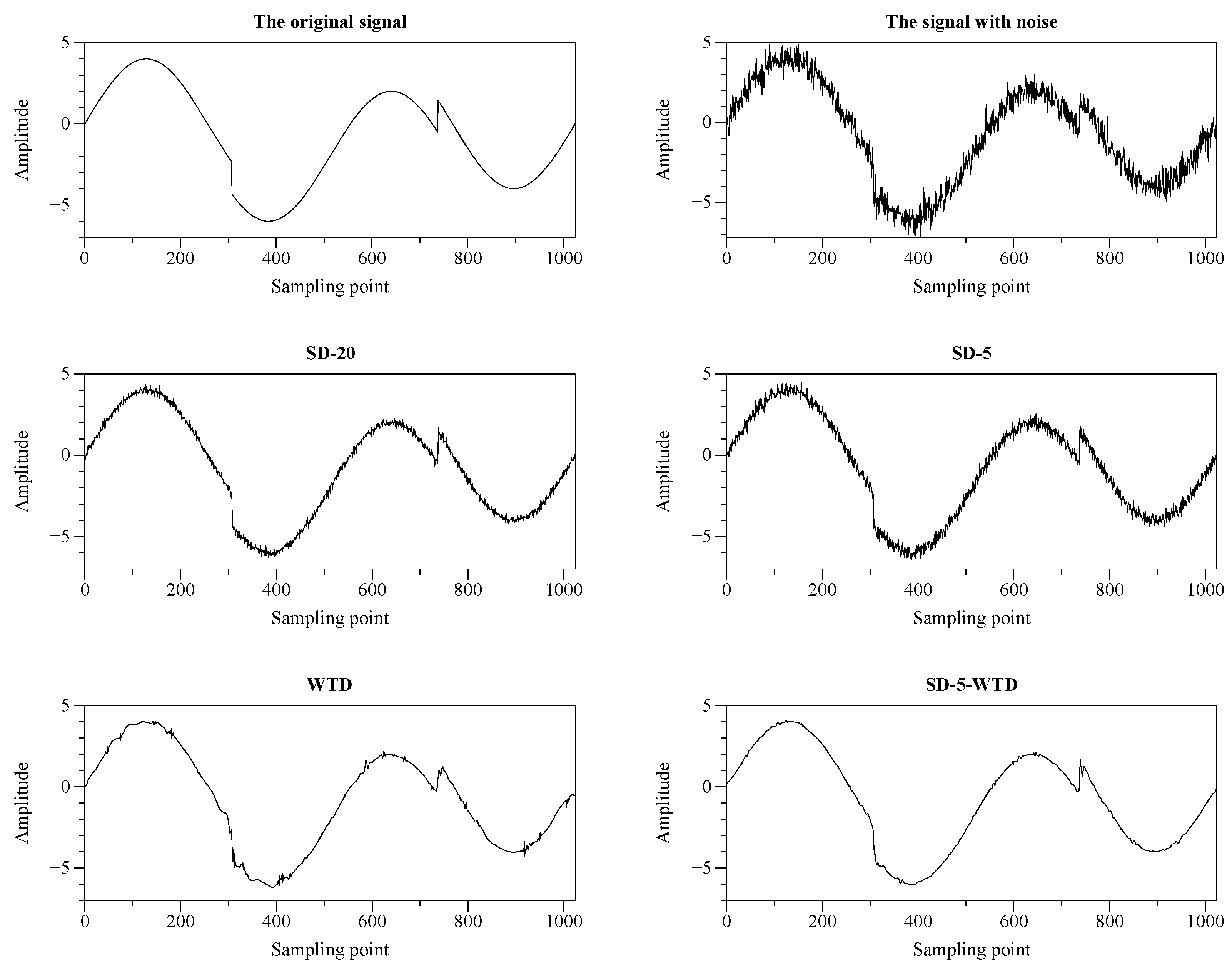
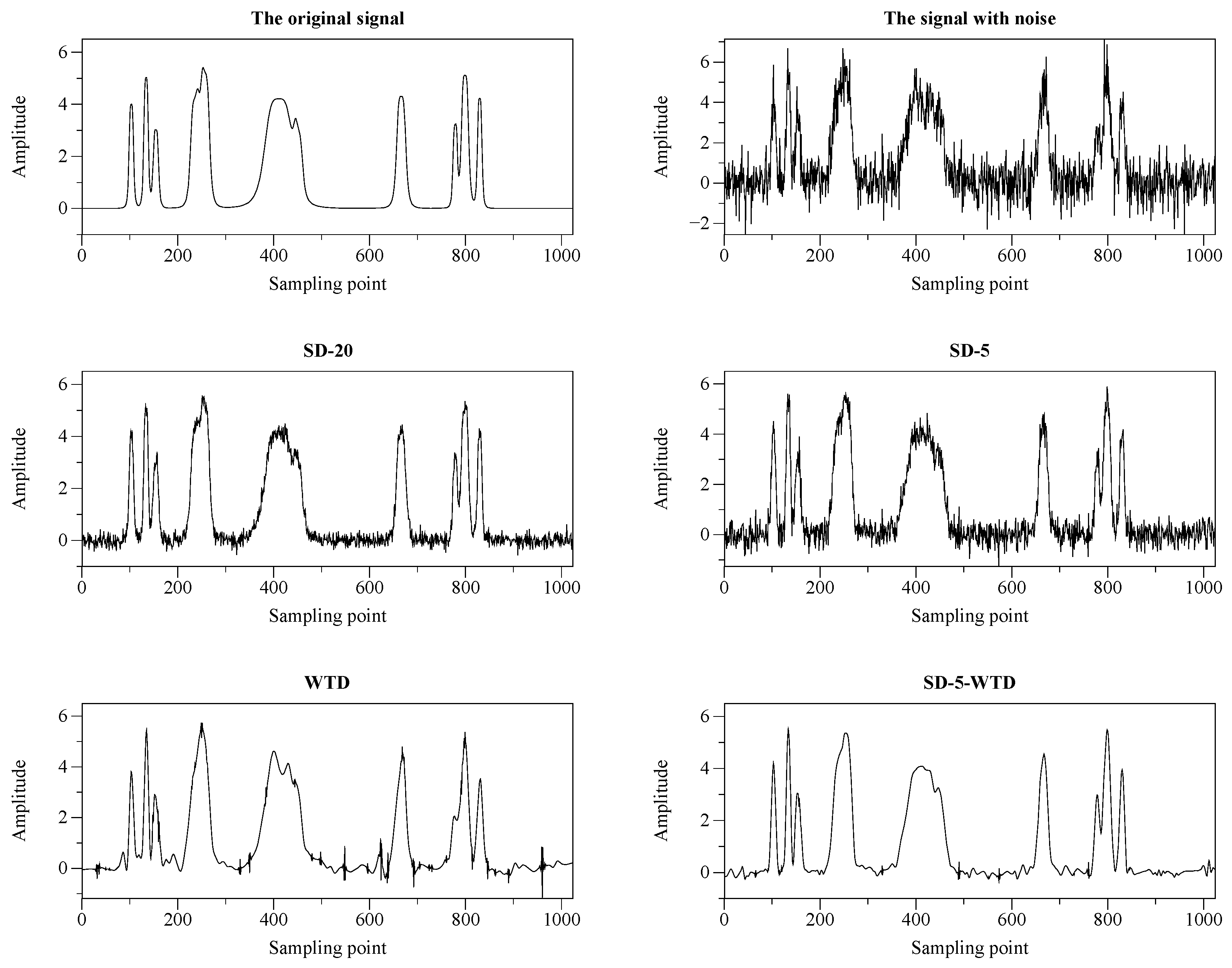
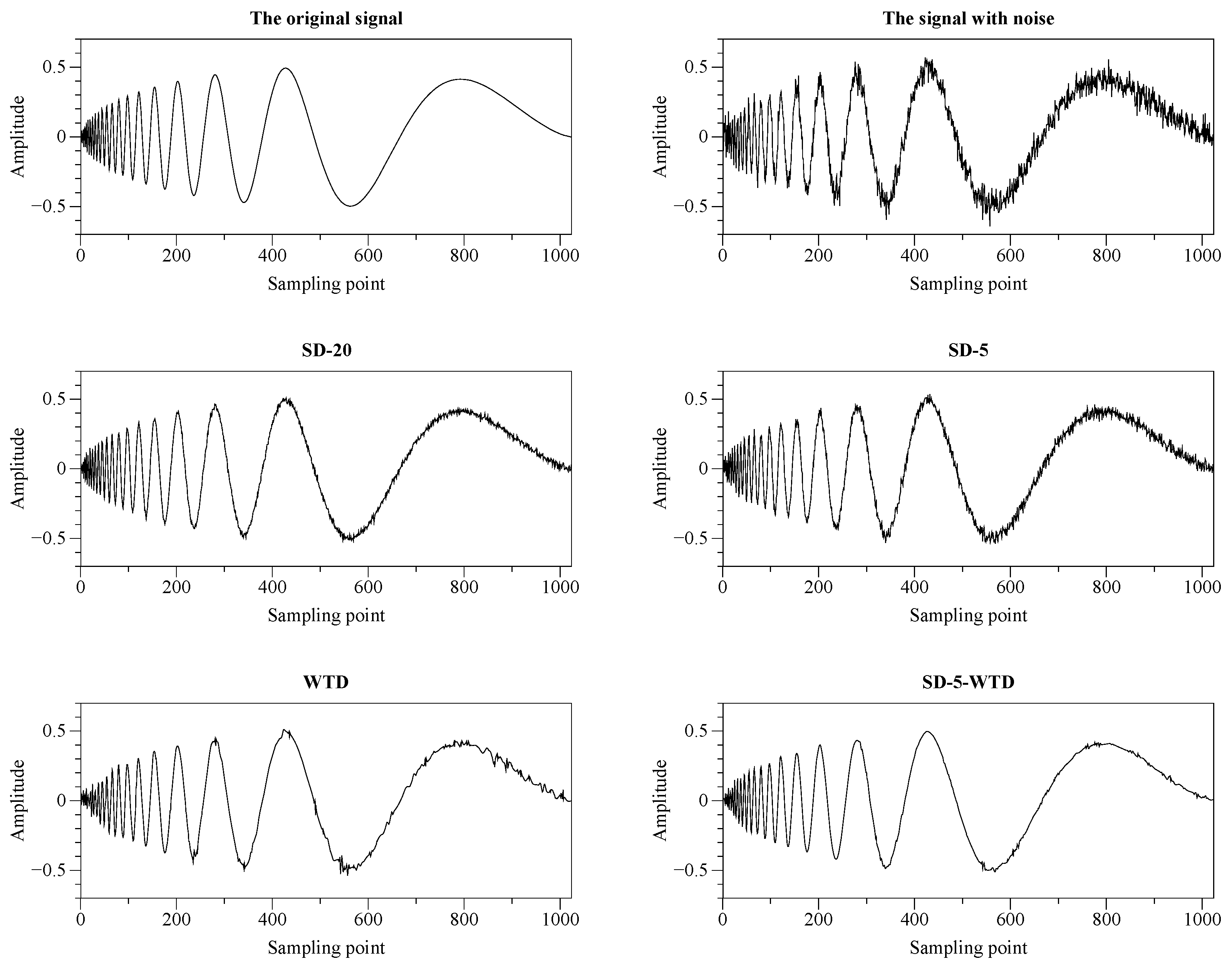

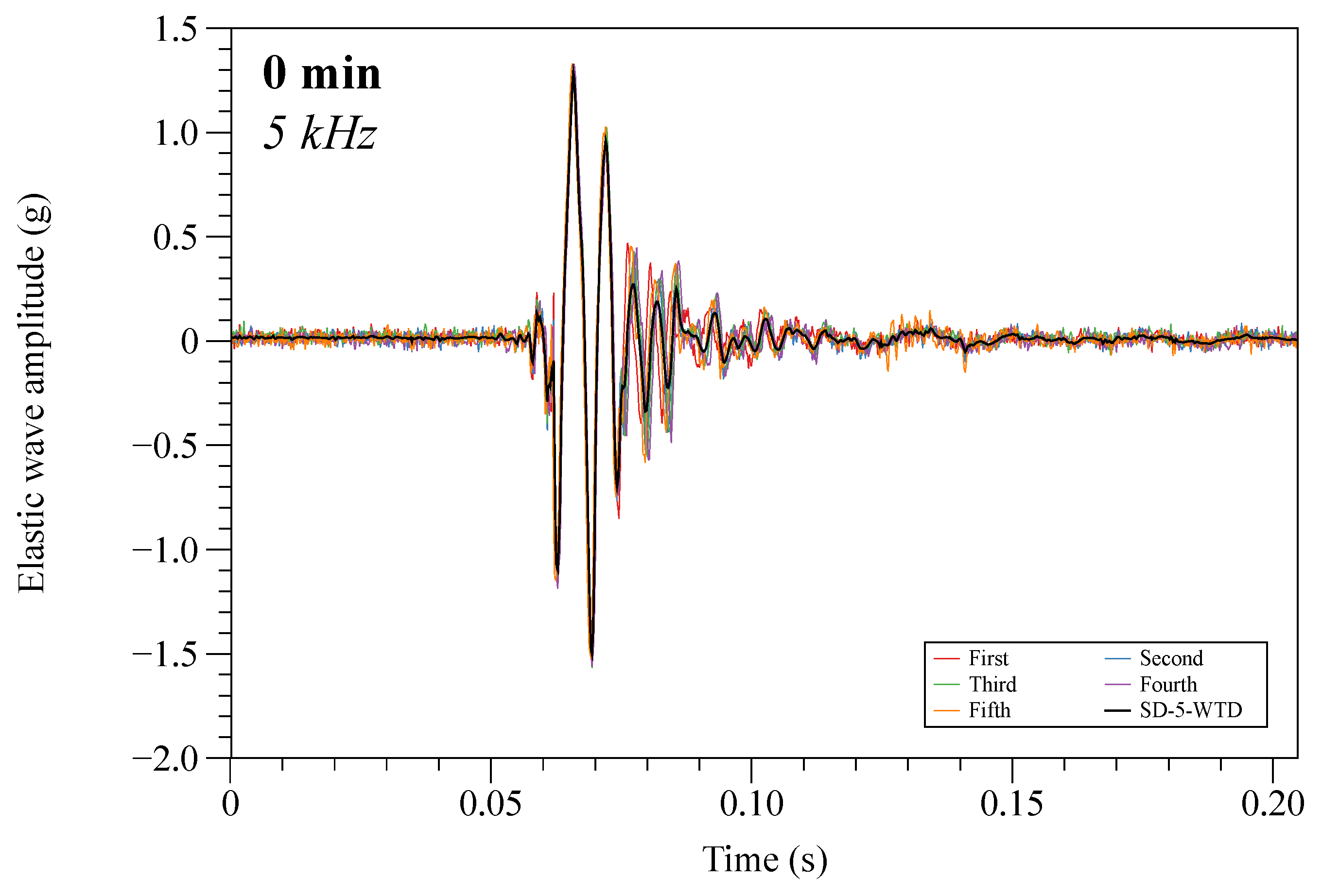
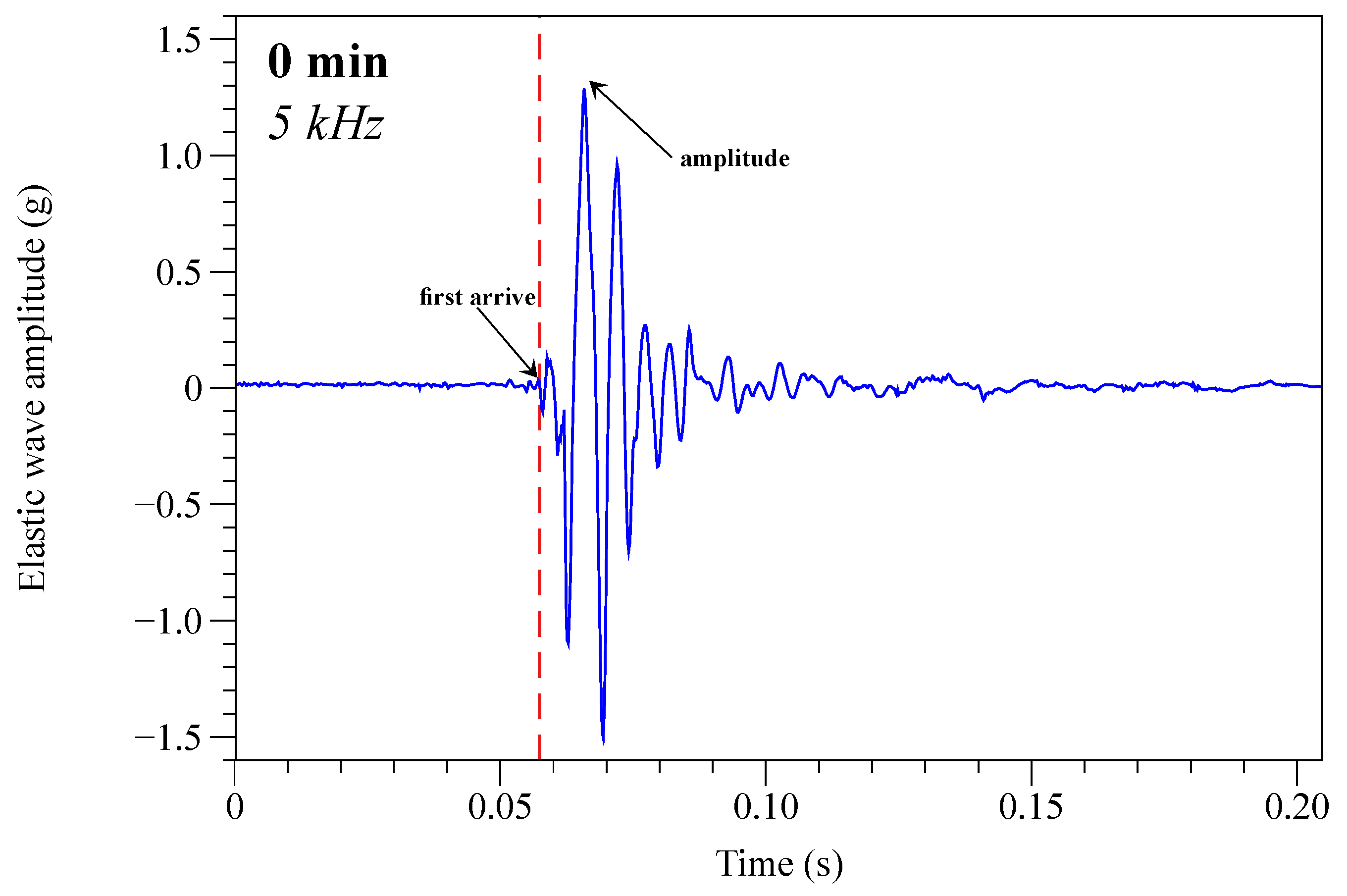

| Denoising Method | SNR | MSE |
|---|---|---|
| SD-20 | 28.8900 | 0.0123 |
| SD-5 | 22.5622 | 0.0528 |
| WTD | 27.2085 | 0.0181 |
| SD-5-WTD | 32.3393 | 0.0056 |
| Denoising Method | SNR | MSE |
|---|---|---|
| SD-20 | 20.1696 | 0.0311 |
| SD-5 | 14.2578 | 0.1215 |
| WTD | 15.1672 | 0.0985 |
| SD-5-WTD | 21.8102 | 0.0213 |
| Denoising Method | SNR | MSE |
|---|---|---|
| SD-20 | 15.0885 | 0.00266 |
| SD-5 | 27.9615 | 0.00014 |
| WTD | 21.9364 | 0.00055 |
| SD-5-WTD | 23.1233 | 0.00042 |
Publisher’s Note: MDPI stays neutral with regard to jurisdictional claims in published maps and institutional affiliations. |
© 2022 by the authors. Licensee MDPI, Basel, Switzerland. This article is an open access article distributed under the terms and conditions of the Creative Commons Attribution (CC BY) license (https://creativecommons.org/licenses/by/4.0/).
Share and Cite
Xie, M.; Liu, J.; Lu, S. Elastic Wave Denoising in the Case of Bender Elements Type Piezoelectric Transducers. Sustainability 2022, 14, 12605. https://doi.org/10.3390/su141912605
Xie M, Liu J, Lu S. Elastic Wave Denoising in the Case of Bender Elements Type Piezoelectric Transducers. Sustainability. 2022; 14(19):12605. https://doi.org/10.3390/su141912605
Chicago/Turabian StyleXie, Ming, Jiahao Liu, and Song Lu. 2022. "Elastic Wave Denoising in the Case of Bender Elements Type Piezoelectric Transducers" Sustainability 14, no. 19: 12605. https://doi.org/10.3390/su141912605
APA StyleXie, M., Liu, J., & Lu, S. (2022). Elastic Wave Denoising in the Case of Bender Elements Type Piezoelectric Transducers. Sustainability, 14(19), 12605. https://doi.org/10.3390/su141912605







